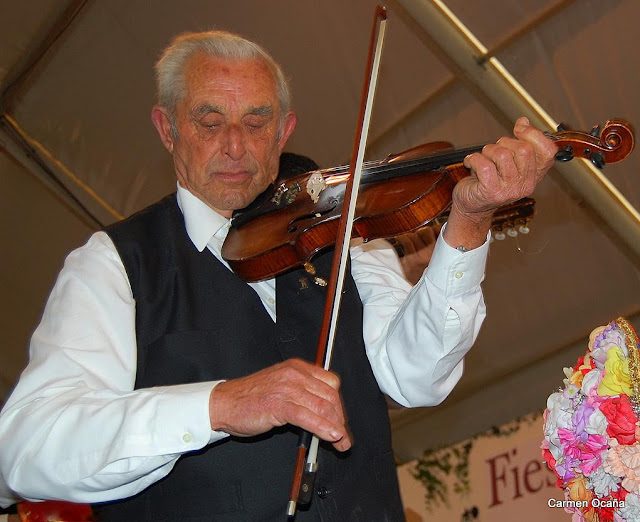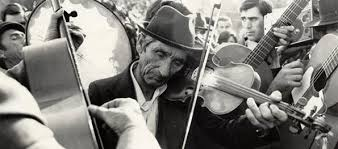The violin, as has been shown in previous chapters, is the soul of verdiales: the one who leads and guides the rest of the group and the one responsible for the melody in this music. That is why this section will be dedicated exclusively to the role of the violin in verdiales: techniques, ways of playing, improvisation linked to the responsibility of accompanying the singers in the best possible way or the way of transmission and teaching, among others.
When playing the violin we can find different techniques, especially in terms of bow strokes.
There are three main bow strokes:
- Legato or tied notes on the same bow.
- Single notes in the form of detaché.
- A bow stroke based on the basic ostinato rhythm which is usually used on long notes to avoid monotony. However, it can also be used for non long notes.
- A bow stroke consisting of a rapid movement of the bow to perform a kind of 'tremolo'.
All this is combined in a free and improvised way while playing according to the circumstances or the violinist's own taste.
In relation to the music for the violin and the styles, a debate has arisen in the course of this research. In the old days, each violinist played his own style and, in fact, nowadays the standardised model of each style is actually the way a particular person played it in the past. All this made me reconsider whether it made sense to classify the verdiales by styles according to geographical area when in fact each violinist had his own style. But the truth is that the three styles have very marked and differentiated rhythmic ostinatos, in spite of how differently the violinist may play.
However, I think it is interesting to bear in mind that in the past you could listen to many different types of verdiales due to the originality of the violin in each panda. For example, within the Comares style, which currently follows the model of the violinist Paco Maroto, there were other violinists with their own styles such as Blas, Antonio Marín or Hilario. There is really no special reason why the playing of one violinist has prevailed over others, simply because of popularity or because verdiales community likes it better1.
Unfortunately, there are no recordings of these violinists. But I have had the opportunity to learn their styles from violinist Antonio Romero and I show them in the following recordings.
One of the most peculiar things to observe in verdiales violinists is how they hold the violin and, especially, the bow. In this popular music, transmitted orally, there is no intentional education on the technique of holding the instrument as we know it in the classical music world. As a result, the most varied positions can be seen.
Although at first glance it may seem that they hold the instrument randomly, without any kind of awareness, the truth is that they take into account some factors. After interviewing the violinist Antonio Romero Ponce2, we have discovered that what violinists generally look for most is their own comfort according to the different bow strokes they have to use. Even, depending on the style they play, they may vary the way they hold the bow, as the needs and techniques change slightly. Therefore, the way of holding the bow or the violin is at the service of the musical needs, as it is the case in classical music.
Video recording 23. Combination of legato and detache in a 'subía' called 'Antigua'. María Estela Lastre Castillo (2023).
Video recording 25. Bow stroke based on the basic rhythm of verdiales. María Estela Lastre Castillo (2023).
Video recording 26. Bow stroke based on the basic rhythm of verdiales combined with legato/detache in 'Antigua'.
María Estela Lastre Castillo (2023).



